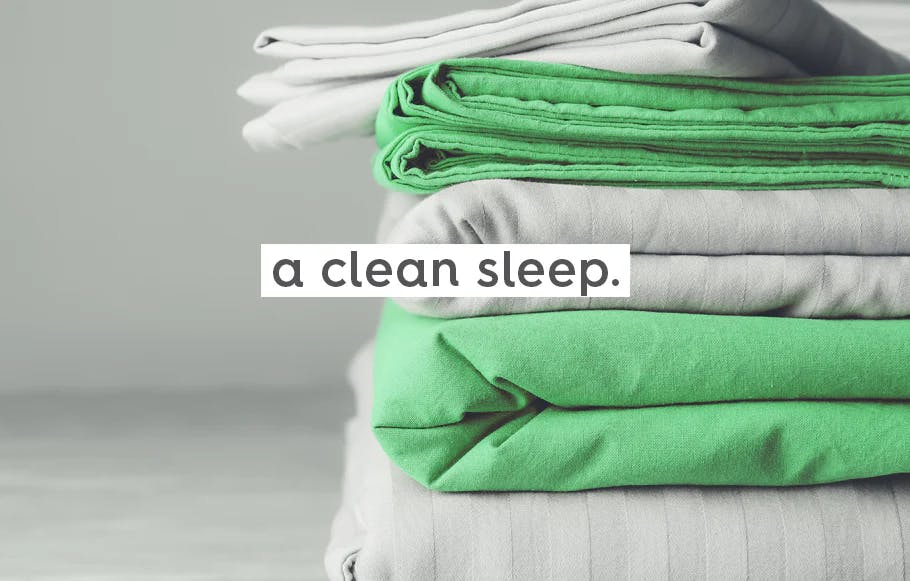14 Jun 2024
We spend about one-third of our life either sleeping (or trying to)* and that mostly takes place in our beds. No wonder for many of us our bed feels like home.
Sadly, it’s also home to extra bedfellows we might not want.
importance of washing bedding
Most people shed 500 million skin cells per day. Much of that ends up in bed and it’s something dust mites can feed on. Not a nice thought for any of us but if we have asthma or allergies, our symptoms can worsen by sleeping on dirty sheets filled with dust mite poop!
And it’s not just that.
Our skin produces sweat and sebum, which deposits into our bedding; we wear makeup, oils or creams on our skin which we wipe off onto our sheets; when we sleep we can drool saliva onto our pillowcases as our swallowing reflex relaxes…. ALL of these substances are food for bacteria and yeasts.
how often to wash your bedding.
If you’re now thinking your bedding could do with a wash… you’re probably not alone.
It’s recommended that we wash our bedding once a week or once a fortnight and here in the UK 64% of us opt for one of these timeframes.
BUT, 9% will go for 3 weeks between changes while 11% extend this to 4 weeks.
And 4% of Britons are happy to wait 2 months or more between clean-sheet feels!**
how to wash your bedding.
1. strip bedding.
Remove pillowcases, sheets and duvet covers for washing weekly or fortnightly. If you have pillowcase protectors and/or mattress protectors you should aim to include these in your wash once a month. Check the care labels on all your bedding so you know the recommended wash temperatures for each.
2. add smol capsule.
Put your smol laundry capsule at the back of your empty washing machine drum and then add your bedding on top. You can use either bio or non-bio capsules but remember if you are washing at temperatures over 40°C you won’t get the benefit of the bio enzymes so your bio will behave more like a non-bio detergent.
3. Add your fabric conditioner.
Ok, this step is optional - but many of us LOVE a little extra fragrance and softness for our bedding. The wonderful fresh outdoors scent of smol fabric conditioner comes from just 4 tiny pumps of our incredibly concentrated liquid. AND it’s animal fat-free (unlike many of the big brand fabric softeners).
4. choose your cycle & temperature.
Remember those extra bed mates we mentioned earlier? You’ll want to clean as many of them away as possible. Washing bedding at 60°C will kill most bacteria so is something to bear in mind if that is a concern to you (for example if you have immunocompromised household members).
If bacteria is not such a worry then a lower temperature of 40°C should be sufficient, especially when using a good quality detergent such as smol laundry capsules.
5. drying.
Line drying outside is always the best way to dry laundry - it doesn’t require electricity AND there’s that fresh outdoor feeling to your sheets. In addition - the UV rays from the sun can kill off bacteria so it’s an extra bit of cleaning thrown in for free.
If you need your bedding quickly and it’s raining (for example it’s your only set) then you might head straight to the tumble dryer BUT there are other options. Dehumidifiers, heated airers and plain old drying racks are also worth a look because there are so many other ways to line dry indoors without having to resort to the tumble dryer.
and what about pillows and duvets?
They’re bulky, hard to dry and we don’t want to ruin them so no wonder 20% of us have never washed our duvets. (Laundrapp).
But whilst we may be ignoring our duvets and pillows… the dirt definitely doesn’t.
A study by Worcester University found that not washing a duvet for 6 months can yield up to 20,000 live dust mites, countless dead dust mites, dead skin cells, and even fungus.
So how can we keep them clean? Head to our complete guide to washing your duvets and pillows for step by step instructions on how to do just that!
and now your bed’s all clean…
… just lie back and enjoy the effects. There are fewer allergens to trigger any sensitivity, less bacteria to cause infections and illness and thousands swear the feeling of clean bedding at the end of the day helps them sleep more soundly and wake feeling more refreshed.
here's some of our other blogs on bedroom cleaning...
- how to wash your duvets and pillows
- how to deep clean your mattress in 5 easy steps
- how to get rid of bed bugs
* Michael J Aminoff, François Boller, Dick F Swaab 2011
**YouGov RealTime 2022
